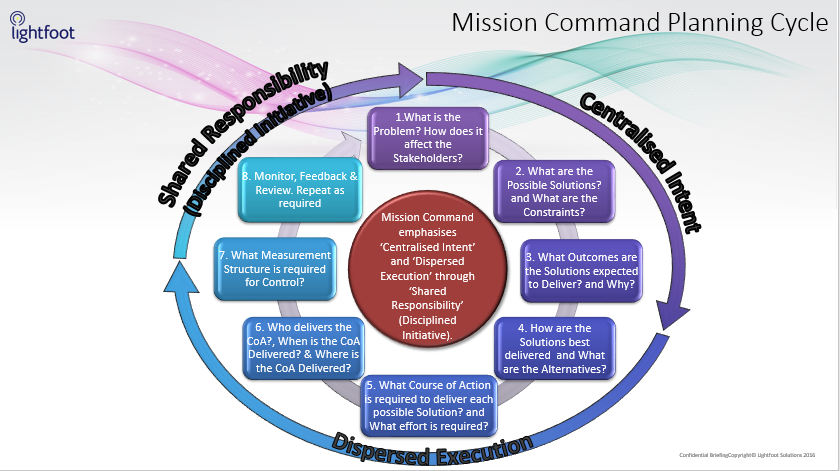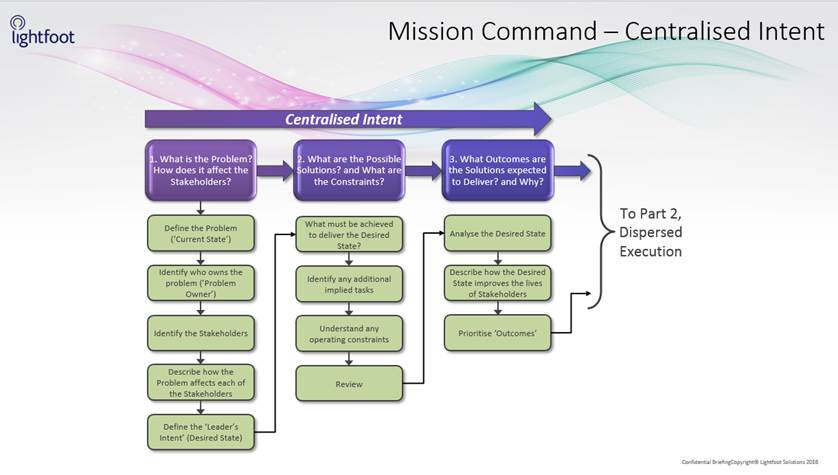Turn The Ship Around, Mission Command, and Staying Out of Trouble (Part four from four)
05/06/2018


In David Marquet’s 2012 book, Turn The Ship Around, his whole effort in making the USS Santa Fe the model of excellence was to change the crew’s attitude from “not making mistakes” to “creating operational excellence”. Although he barely touches on the concept of Mission Command (to be fair Stephen Bungay’s book on the subject – Art of Action was only published this year) – it was Mission Command / Centralised Intent that he was implementing throughout his boat.
We introduced and have been covering the initial 2 of the 8 Stages of Mission Command in three previous blogs.

Last time we covered Stage 2, and this time we’ll address Stage 3.

3. What Outcomes are the Solutions expected to Deliver? And Why?
a. Analyse the Desired State: Having worked through the Steps in Stages 1 and 2 above, the manager is now ready to express and make clear his/her own intent. What are the effects he/she wants to have on the situation, the purpose of each effect and the ways progress can be measured? It may even be helpful to outline a selected solution (from the Possible Solutions in previous Stage 2). Typically, the desired state is articulated with clarity and simplicity – e.g. as verb-object.
For example, working with a large Police Force: In an Understanding Demand Project, the Desired State is expressed as Improve the Flow of Work. This can only be done by examining each Flow in its own right. For example, there is a Flow associated with Preventing Burglaries, a separate Flow associated with Allocating Crimes to Detectives to Investigate etc. Then there is the necessity to Monitor and Evaluate any improvement Action. This means using the appropriate Measures (and Measurement Methods) to measure the result of the change.
For example, working with a large Police Force on a larger scale: Working out from the PCC Crime and Policing Plan, one Desired State is expressed as Prevent, Solve and Reduce Crime. Again, this can only be done by examining the Flow associated with each major Crime Type (there are some similarities across some Crime Types, obviously). So to prevent Burglary Peaks, the Force would identify the main months – in this particular case it was September through November each year. Then locations – in this case mainly in student occupied rental accommodation. The plans to combat this are out in Stages 4 – 6 under Dispersed Execution in the top diagram above. But it is simple to state at this, Stage 3, what Outcome is wanted (Reduction in Burglaries), and What to Measure (number of Burglaries (and possibly number of successful Outcomes)), and the Method for measuring the result.
For example, working with a large Telecommunications provider: Working from Group Central Intent (All stakeholders will experience a better world through the company harnessing the power of communications), out to Divisional Central Intent (Provide responsive, reliable service over copper and fibre connections between exchanges and customer premises) out to the front-line where the impact of action can be measured (Roll-out fast broadband On-time and Fully-operating).
b. Describe how the Desired State improves the lives of Stakeholders: Here we describe the impact on the customers or public we are serving from their perspective.
For example, working with a large telecommunications provider: By rolling out fast broadband On-time and Fully-operating means customers will get a service where broadband works, does not buffer or drop, and with the speed and throughput they purchased.
For example, working with a large Police Force: By preventing Burglary Peaks (in September through November), residents (mainly students) will feel safer, and maintain belongings that are of value to them.
c. Prioritise Outcomes: Here we aim to determine, where there are several Outcomes or Sub-outcomes, what priority each one takes.
For example, working with a large telecommunications provider: Is the fact that broadband works more important than it buffering (obvious), is speed the next most critical, or is it that it doesn’t drop, or are customers OK with some buffering at the expense of speed?
For example, working with a large Police Force: Are students more concerned with hanging onto their valuables, rather than feeling safe (i.e. some people see a visible police presence as a good thing and feel safe, others see it as a worry that there needs to be a police presence, that bad stuff happens around here, and so feel unsafe).
Many organisations that we have had the pleasure to work with recognise that “staying out of trouble” is a never-ending, fire-fighting vicious circle. Working together, we’re starting to see how the 8 stages of Mission Command / Central Intent are the basis of a virtuous circle, and can lead organisations out of being reactive and into preventative states.
In building Mission Command / Central Intent, we’ve focused on Stages 1 – 3 in these blogs. This is because it is these stages that are most often overlooked, done badly, or not known about at all! Also, these stages are iterated and repeated working from the centre out towards the front-line. Once you get close to the front-line, then Stages 4 – 7, Dispersed Execution, will come into play.
We’ll take a look at these latter stages in this blog in a few weeks’ time.
Categories & Tags:
Leave a comment on this post:
You might also like…
Automotive Engineering: From student to hypercar innovation at Rimac
We sat down with recent graduate Thomas Perrin, to discuss how his year on the MSc in Automotive Engineering at Cranfield University propelled him from the lecture hall directly into the ...
What this year at Cranfield really meant to me
Every Cranfield journey is unique. In this alumni reflection, Zachea Scicluna shares what her year at Cranfield truly meant, from facing uncertainty to gaining hands-on experience in industry-backed projects. I’ve been reflecting (and delaying) ...
Preparing for assignments and exams?
Sorry! We know it seems a bit mean to mention the exams in January rather than looking forward to the break before it! However, we know many of you will be thinking about your forthcoming ...
Screening for FTSE 100 companies on Bloomberg
So you’re researching an index and need some data on its constituent companies? Bloomberg’s Equity Screening tool makes light work of this, not just for the FTSE, but for indices, exchanges and sectors worldwide. Type EQS ...
Accelerating my future: How Cranfield put me on the fast track to automotive safety innovation
Hello! I’m Michaela Kaiser, and I’m thrilled to share my journey studying abroad. I’m from Calgary, Canada, and I recently graduated from Cranfield’s MSc Automotive Engineering course. My path to Cranfield ...
From Myanmar to Cranfield: My path to Renewable Energy
As someone who is passionate about sustainability, my career goal is to build a path in the renewable energy sector. My aspirations comes from the benefits of developing sustainable energy sources and ensuring energy ...






